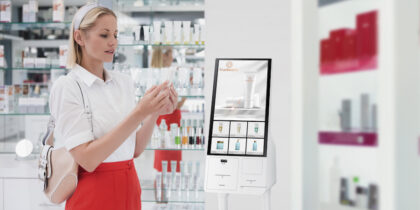Out of nowhere in 2016, a mobile augmented reality phenomenon exploded onto the scene. Pokémon Go caught everyone by surprise when it generated $600 million in revenue in just three months. The surprise hit has made smartphone game and app developers sit up and take notice, but it has also been a signal to enterprises that augmented reality (AR) is a phenomenon they should be paying attention to today.
As a result of being launched at the right time — combined with users’ genuine affection for the brand — Pokémon Go struck a sweet spot, but it was the fun and immersive experience users found when they used the app that kept millions of people playing for so long.
While smartglasses that offer a truly augmented or mixed reality experience for consumers are still some years away, today’s smartphones offer technologies that companies can leverage to not only give added benefits to their customers, but also allow them to collect critical insights into their behavior.
Mobile AR Technology
The recently launched Samsung Galaxy S8 smartphone includes a range of enhanced camera capabilities that show just what today’s smartphone technology can do in the augmented reality arena. With Bixby Vision, Galaxy S8 users can simply hold their phone’s camera up to a landmark and get contextual information to augment what they are seeing around them. They can take a picture of a product and immediately be provided with a link to buy the item online. With Bixby Vision, Samsung’s Galaxy S8 can translate languages, scan bar codes or read business cards. Companies need to be aware of this technology, as they can leverage it to promote themselves to people who are actively looking for something, and provide a unique experience for their customers.
Revolutionizing Retail Through Technology
View the infographic to learn how digital technology is transforming the shopping experience. Download Now
They can take a picture of a product and immediately be provided with a link to buy the item online. With Bixby Vision, Samsung’s Galaxy S8 can instantly translate languages, scan bar codes or read business cards. Companies need to be aware of this technology, as they can leverage it to promote themselves to people who are actively looking for something, and provide a unique experience for their customers.
While many see AR as a technology of the future, it’s clear that mobile augmented reality is already here.
Taking Advantage of Mobile AR
Companies and their CMOs are already seeing the potential benefits of augmented reality and the immersive experience it can give their customers. Here are three examples of businesses that are taking advantage of AR today:
- Tiffany & Co. — The jeweler launched its Engagement Ring Finder app to help brides-to-be decide on which ring they should buy, giving them custom filters to show what the ring looks like in different lighting conditions.
- IKEA — With many of its customers returning furniture because it didn’t fit in their home, the Swedish furniture giant launched an AR version of its catalog, which allows users to see what a new sofa or table will look like in position in their sitting room or kitchen.
- Indestry — A content development firm for educational AR content, Indestry, has created a Back to the Jurassic app so that users can engage with and observe dinosaurs in their surroundings. This not only brings prehistoric content to life, but out of the museum and beyond a diorama-like exhibit.
Whether you’re looking to progress your relationship, buy furniture or unleash dinosaurs into modern society, AR technology can add a sense of fun in addition to offering obvious, practical benefits for users.
First Steps
As you can see from these examples, they all offer intuitive and fun experiences that don’t detract from the goal of driving revenue and engagement with the real-world product. While CMOs need to make sure they are looking for ways to incorporate augmented reality into their customer experiences, they should also be aware that just adding AR features without considering how they work is not a good idea.
To make augmented reality work for you and your customer, a business needs to ensure that the AR feature is seamless and not jarring. Ideally, you want to engage the customer in a way that will see them share their experience with others, so that you will grow your customer base organically.
To do this, companies need to look not only at the hardware their customers are using to access their services, but at how their customers already use their apps. Are customers using it in their homes or in public? If the former, then adding more personalized content may work, while the latter lends itself to content that is designed to inform.
The Future
Mobile augmented reality is just beginning to take off, but we are already seeing the start of an era when AR will be a key way we experience content. There are still some hurdles which have to be addressed before AR becomes a mainstream technology, but just as smartphones quickly became pervasive, headsets and smartglasses offering overlaid digital content on the world around us could quickly become the norm — and your business needs to be ready.
Trends that are contributing to the rise of the digital workforce include augmented reality and the Internet of Things.






